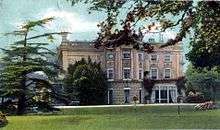Manor of Copped Hall
The Manor of Copped Hall (or Coppeed Hall) was located to the south of St Andrews church in Totteridge, Hertfordshire, in an area that is now part of the London Borough of Barnet. There is a separate Copped Hall, also known as Copt Hall or Copthall, close to Epping, Essex.


Early history
The early history of the manor is uncertain but it may be the capital messuage held in the 16th century by John Copwood who owned it at the time of his death in 1543, leaving a daughter Sophia. It seems to have passed soon afterwards into the possession of the family of Clyffe. Richard Clyffe held a "manor or capital messuage" in Totteridge at his death in 1566, leaving it to his illegitimate son William Clyffe or Smyth, with remainder to Richard's brother Geoffrey and his son Richard. In the following century it was held by Edward Clyffe, who died about 1635, leaving two sons, William, on whom the property was settled, and Edward.[2]
Later history
In 1722 the manor was bought by Joseph da Costa (1683-1753), a wealthy Portuguese-Jewish merchant, when it had formal gardens[3] and a large house. In 1758 it was bought by Abraham Chambers a London Banker. The grounds were later re-worked by Humphrey Repton to give a more natural appearance.[4]
In the nineteenth century, Copped Hall was for some time owned by William Manning, father of Henry Edward Manning (Cardinal Manning), who was born there in 1808 and sold it in 1831. It was sold by auction in 1850. From 1875 it was occupied by Sir Samuel Bagster Boulton (1830-1918), who enlarged the house.[2]
The house was later known as Darlands. It was demolished in 1928[5] by George Herbert Kemp, a biscuit entrepreneur. The grounds became a nature reserve in 1971 and a Site of Special Scientific Interest.[4]
References
- Badeslade & Roqeu, Vitruvius Brittanicus, Vol. IV, 1739.
- Parishes: Totteridge. British History Online. Retrieved 21 October 2016.
- Hemming, T.D.E., E. Freeman, D. Meakin (Eds.) (1994). The secular city: Studies in the Enlightenment presented to Haydn Mason. Exeter: University of Exeter Press. p. 49. ISBN 978-0-85989-416-6.CS1 maint: multiple names: authors list (link) CS1 maint: extra text: authors list (link)
- Hulme, Sheila. (2010) A brief history of Totteridge Valley. London: The Mill Hill Preservation Society. p. 5.
- Pevsner, Nikolaus & Bridget Cherry (2002). The buildings of England London 4: North. New Haven & London: Yale University Press. p. 189. ISBN 0300096534.